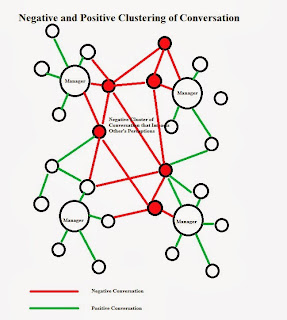Communication is social by nature, helps others to
engage in relationships, and link the micro actions of individuals to the macro
actions of the organization. The communication patterns of a workplace
determine not only the culture and flavor of the company but also its
effectiveness. The researchers Keyton,
et. al. (2013), discuss the nature of communication in the workplace and the
patterns formed.
Employees who are effective communicators are likely
to succeed in achieving their goals. Individuals are seen as active agents
whose behaviors are driven by motivations that are innate (Bandura, 2008). Such
individuals express themselves, their personalities, and even their unconscious
conflicts through communication.
Let us take two examples of people who have distinct
communication patterns within the workplace. Tom wants to be successful and
seeks recognition for his work. John feels as though he is more deserving of
others and the only way to achieve his goals is to dominate others around him.
Both will develop a communication pattern to meet their goals.
Tom talks about the great things he has done and
seeks recognition and approval. John is hyper critical and talks poorly of
others abilities. Tom likes to talk out differences while John seems to push
his agenda on others. Tom learns from others and John negatively compares
himself to others. Both have developed a pattern.
Tom and John’s behaviors are both addictive.
Communication is social and others gauge their environment by the behaviors
around them. If Tom works hard, manages conflict, and seeks recognition and
this results in success others will begin to copy Tom. If John’s brashness and
negativity is rewarded others will assume that is what makes success. One
workplace will become more productive while the other will become more toxic.
Of course, Tom and John are not the only people in
the workplace. Therefore, the total communication flow is based upon up the
collective pattern of the environment. These patterns are defined as the
culture and value systems of a company. To change culture and patterns can mean to
change the conversations, reward systems, and basic economic assumptions of the
environment.
The researchers sought to understand what
communicative behaviors the workplace has experienced based upon the perception
of employees. Within their target they found that the ten most common verbal
communication patters were listening, asking questions, discussing, sharing
information, agreeing, suggesting, getting feedback, seeking feedback,
answering questions and explaining. These observed patterns suggest a workplace
that seeks to be efficient and the communicative patterns appear to support
that effort.
A second study found some differences. Routinely
used verbal communication behaviors exhibited were information sharing,
relational maintenance, expressing negative emotion, and organizing. Even
though each of these are common it should be understood that relational maintenance
should not be excessive and expressing negative emotion should be productive.
If they do not add to the success of the organization, it is possible that
excessive amounts of time in social structure maintenance and negativity can
create a non-mobile and toxic workplace.
Understanding
what communication patterns employees are using can determine overall cultural
values and communicative behaviors within the workplace. Surveying employee’s
perceptions of communication patterns within the workplace will help solidify for
decision-makers the most common interactions. By understanding these patterns,
it is possible to make adjustments that further help the organization develop
proper workplace assumptions that lead to productivity.
When conducting similar studies it may be beneficial
to break up the surveys into the following:
1.) Executive Communication Patterns: How do
executives communicate with each other and employees?
2.) Employee Communication Patterns: How do
employees perceive the communication patterns within the workplace?
3.) Employee to Customer Communication Patterns: How
do customers perceive the communication patterns coming from employees?
Bandura, A. (2008). Social cognitive
theory. In W. Donsbach (Ed.),
The international encyclopedia of
communication[electronic version]. London, England: Blackwell. doi:10.1111/ b.9781405131995.2008.
Keyton,
J. et. al. (2013). Investigating verbal workplace communication behaviors. Journal of Business Communication, 50 (2).
Other Reading:
